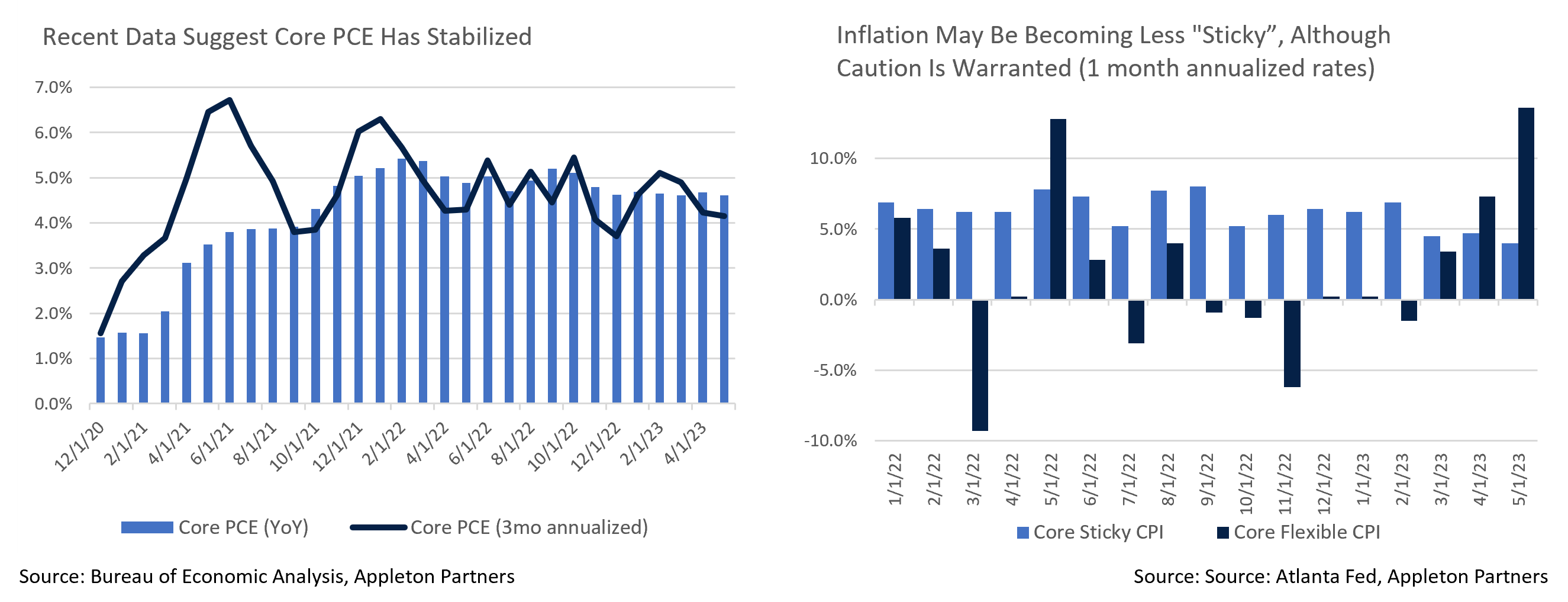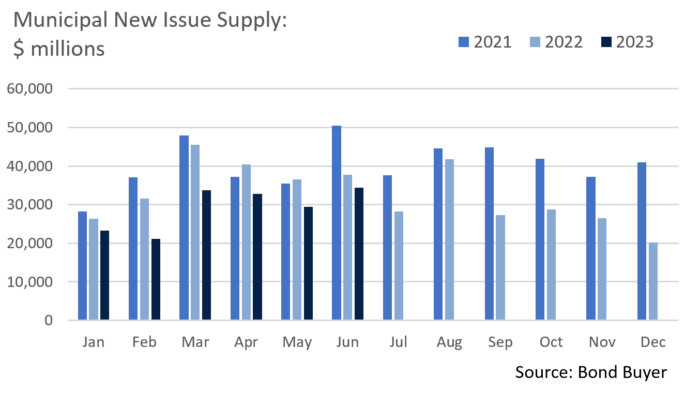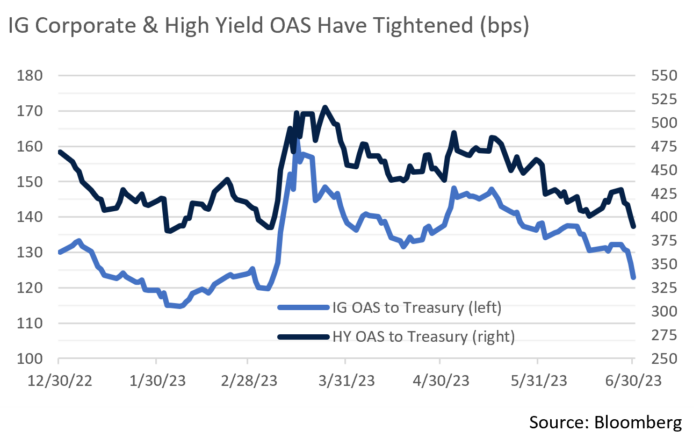Insights and Observations
Economic, Public Policy, and Fed Developments
- While the June 14th Fed meeting gave us the “hawkish pause” the market was anticipating, investors severely underestimated the degree of hawkishness the Fed delivered. Year-end Fed Funds Rate expectations were lifted to 5.6%, a full two hikes higher than the previous “dot plot,” while 9 of the 18 members favored 2, 3 favored 3, and 1 favored 4 additional hikes in 2023. Only 2 members preferred leaving rates unchanged, down from 7 in March. We have long argued the Fed’s commitment to beat back inflation is ironclad and when they say they will hike, investors ought to listen. If there’s any uncertainty in this projection, we think it remains to the upside, and that hikes extending into 2024 are not out of the question. While rates were initially slow to respond, the policy-sensitive 2Yr UST ultimately breached 5% to levels not seen since 2007, and Fed Funds futures have gone from pricing 3 cuts by year-end to somewhat more than a single hike.
- While annual headline inflation continues to improve, much of that improvement comes from base effects as ultra-hot 2022 months drop out of the trailing year, and from a decline in energy prices. This means recent YoY progress is likely to stall. Monthly core inflation remains high and consistent with a 4-5% annualized rate. Media attention remains squarely on the former, whereas we expect the Fed to focus on the latter.
- Consumers remain unexpectedly resilient despite the Fed’s rate hike campaign. Retail sales, housing starts, and durable goods sales all posted strong upside surprises in May. Core durable goods spending may have been offset by a downward revision to April’s report, but this leaves a less volatile two-month period that still shows strong consumption. Similarly, the third revision of Q1 GDP reported the strongest quarterly consumer spending in two years. And, while June employment missed expectations, wage growth was still strong and hiring continues at a pace that does not suggest a stalling economy.
- While a slowdown in China has helped weaken global aggregate demand, the Chinese government is not prepared to accept slower growth, and state-controlled media have begun calling for stimulus. Commodity prices are stabilizing in response, and if stimulus is forthcoming this could become an external inflation source.
- While our base case remains that stubbornly high inflation will require further rate hikes, at least two data points could make us revisit this view. First, PPI purchaser inflation has slowed to near the Fed’s target. This may indicate businesses are attempting to “right size” inventory levels in advance of a slowdown. However, it also fell off a cliff in March during the SVB implosion and may represent a business reaction to an anticipated consumer spending freeze that never occurred. Second, while core inflation remains high, the Atlanta Fed’s Sticky Price CPI monitor shows the mix of core inflation tipping from sticky to flexible. If this continues, core inflation could drop faster than expected. We note that healthcare measurement differences between CPI and PCE that caused core CPI to overshoot core PCE in the first place appear to now be correcting and pulling CPI back down, and if so, we expect to see those normalize in the sticky price index as well.
- On a historical note, the LIBOR rate was reset for the last time on June 30th. In its peak, trillions of dollars of financial contracts were priced on this short-term lending rate before a rate-rigging scandal led to its demise. Its replacement, SOFR, is a market-based risk-free rate that should prove much less susceptible to manipulation.

Equity News and Notes
A Look at the Markets
- June was a strong month for stocks as all major indices advanced and the S&P 500 gained +6.5% to raise its YTD return to +16.9%. Both the S&P 500 and Nasdaq closed Q2 on 4-month winning streaks.
- All 11 S&P 500 sectors were positive in June with cyclicals resurgent as Industrials (+11.2%), Materials (+10.8%), and Financials (+6.5%) all outperformed. Sector strength of this nature is a sign that investors are increasingly embracing the potential for a soft economic landing after weathering longstanding recession speculation. Mega cap technology names had previously driven 2023’s performance and greater market breadth is welcome.
- The first half of the year has been historic with the S&P 500 enjoying its best start since 1998. The tech-heavy Nasdaq (+32.3%) nearly doubled the S&P and has produced a YTD return the index has not seen in 40 years. The S&P 500 entered a bull market (20% increase from recent low) in early June and ended the quarter more than 24% above its October 2022 closing low and only ~7% away from January 2022’s all-time high, a remarkable turn of events.
- Valuation raises concerns relative to the durability of this rally as the S&P now trades at a 19.1x forward P/E, 16% above the 10-year forward P/E average of 16.5x. As discussed in our May report, narrow market breadth has contributed to rising index valuations, with the top 10 companies in the S&P trading at 29.3x forward P/E. The largest market cap names have traded at significant premiums to flight to safety stocks, a dynamic influenced by the frenzy of interest in companies leading or even strongly associated with artificial intelligence. Removing the top 10 S&P 500 companies produces much different index valuation, with the remaining index constituents trading at a reasonable 17.8x forward P/E, only ~8% above the 10-year average. While index composition is what it is, conditions of this nature give active managers an opportunity to manage risk and potentially outperform.
- The Federal Reserve held the target Fed Funds rate in a 5.00-5.25% range in its June meeting after 10 previous post-meeting hikes. Nonetheless, the Fed’s comments were hawkish and most observers, ourselves included, see this as more of a “skip” than a true pause. Holding rates in check for now gives the Fed time to measure the effect of an extended rate hike cycle as there is often a lag in monetary policy’s impact on economic data. Chairman Powell and other Fed officials have previewed that at least two more hikes may be forthcoming before year-end and prior speculation of late 2023 cuts now seems off the mark. Odds for a 25bps rate hike in July have increased from 60% to >85% since the end of May and we feel investors will need to factor in a higher for longer rate trajectory into market and company specific stock analysis. Though growth names have rebounded in 2023, rising interest rates could reward value-oriented, lower multiple names. Growth stocks could begin to lag, especially as company fundamentals come into focus in the second half of the year.
- The latest consumer data show Q2 real consumer spending on track to grow at just an annualized quarter-over-quarter rate of +1.0%, with nominal up less than +4%. As personal savings propped up by pandemic related support steadily decline, consumption may begin to slow. The economic outlook and its impact on corporate earnings faces countervailing forces, as the labor market remains a bulwark against recession with June’s ADP Payroll report showing month-over-month gains of 497,000 turning heads. On the other hand, the prospect of a resumption of student loan repayments, record high credit card balances, and further upward pressure on interest rates create a gloomy backdrop for 2H spending which could weigh on the consumer discretionary and information technology sectors. Consumers may opt to trade down by purchasing lower priced goods, which favors defensive sectors like consumer staples. Healthcare and utilities sectors also tend to provide portfolio stability amid weaker economic conditions.

From the Trading Desk
Municipal Markets
- Munis started the month of June well bid due in large part to technical factors, including strong inflows and a better-than-expected non-farm payroll number that pushed Treasury yields higher. Valuations were trending toward rich levels early in June with most maturities in the lower end of fair value with the 10Yr Muni/UST ratio at 70% and 30Yr ratio at 91%, although the very front end of the municipal curve was more expensive. June ended with 10Yr and 30Yr ratios of 67% and 90%, respectively.
- Bid wanted lists have been heavy, yet this inventory has not added much to our buying activity given that most bonds were either on the very front end of the curve or longer maturities with shorter call options. Liquidation of the FDIC bank portfolio continued in June, adding to supply although this has not had much impact on overall trading levels and price discovery.
- As we approached mid-month, the new issuance calendar remained muted, and volatility picked up ahead of the Federal Reserve meeting. Munis outperformed USTs in the aftermath of hawkish mid-year Fed commentary as market expectations began to anticipate more Fed Funds rate hikes this year.
- With no clear impetus for increased new issue inventory, strategists at several of the major dealers have recently cut their supply forecast estimates. Overall municipal supply is down about 20% vs. the same time period of 2022, and constrained issuance has created a favorable technical dynamic that should continue to support market prices. We feel that net supply will remain stagnant until state and local governments begin to experience greater budget strains and/or interest rates recede. Most municipalities still have considerable federal aid on their balance sheets and many states have record high rainy-day funds that currently limit their need to access the public debt markets.
- New York City recently received federal approval to charge motorists driving into the city, a policy known as “congestion pricing.” The approval was needed before construction on the tolling could begin. We see this as creating a precedent that may spread to other major markets, positively impacting the revenue generating capacity of large bond issuers.

Corporate Bond Markets
- The Investment Grade Credit rally that began in May trickled into June as spreads ticked towards YTD lows. That low (115bps OAS) was reached in early February and IG spreads have not come close since that time. That is until the OAS on the Bloomberg Corporate Bond Index rallied 8bps over the last few trading days to end the month and quarter at an OAS of 123bps. Much of this move can be attributed to more signs of American consumer resilience and sustained strong overall economic data, along with month-end rebalancing after an extended equity rally. Q2 earnings will be closely watched for signs of a weakening of these trends. Our view is that spreads have settled in close to a near-term bottom, although this is highly subject to change given volatile economic dynamics.
- High Yield has been one of the better performing asset classes with credit spreads falling close to their YTD lows of 390bps. While we do not invest in high yield issues, this market is a valuable source of credit intelligence. Like Investment Grade credit, High Yield credit is benefiting from surprising economic strength, and risk appetite among investors remains strong as a result.
- A strong bid for risk assets has encouraged high yield issuers to come to market, driving issuance up 37% YoY. Of the $92.7 billion in below investment grade new issues, $53.8 billion came to market in Q2, bond offerings that have collectively done very well. We do not see much room for spreads to go lower from here and see the high yield primary market providing sustained supply.
- According to Refinitiv Lipper, Investment Grade US Corporate Bond net fund flows were very strong in June at +$7.6 billion. So far this year, 66% of the weeks have produced net positive IG Credit fund flows, a sentiment indicator that is supportive of relatively tight spreads and firm price levels.

Financial Planning Perspectives
The Path to Higher Education – Application and Aid Considerations
 This month’s commentary and the one to follow present a two-part series on a pressing matter faced by many families – college admissions and financing.
This month’s commentary and the one to follow present a two-part series on a pressing matter faced by many families – college admissions and financing.
College Applications – Where, When, and How
As spring turns to summer, many rising high school seniors and their parents are turning their attention to the college admission process. The process can be somewhat complicated and intimidating, and if they haven’t done so already, we recommend families focus in earnest on approaching college admission deadlines. As with other planning matters, getting ahead of the process by developing a well thought out strategy based on defined goals not only enhances one’s opportunity to gain admission to the colleges of their choice, doing so can help make a stressful process more manageable for families.
Once a senior has identified which schools are likely to best fulfill their educational and personal goals, a timetable for these applications must be developed. There are three primary application options:
Early Decision | Provides the student with the opportunity to apply to one college for an admission decision (provided the student has submitted their standardized tests scores and other required information before November 1st of their senior year). Schools usually provide an early decision determination to applicants by mid-December. Applying with an early decision timetable can be beneficial to those students who have identified a single, top priority school. If accepted by way of early decision, the student is required to attend the school, therefore this option is only recommended if a student is sure about their choice. |
Early Action | Early action is similar to early decision in terms of requirements and timetables, although early action applications do not require students to attend the school should they be accepted. Students can apply to multiple schools using the early action approach and most schools notify applicants of their decision during a period from December 1 through January 31. |
Traditional College Applications | This approach offers students more time to decide where to apply as applications are not typically due by January 1st or February 1st with decisions made in March or April. However, admissions rates are often somewhat higher when applying early decision or early action. Most advisors recommend complementing a potential early decision application, and/or early action submissions, with additional traditional applications. |
While students are free to complete and submit applications directly to the institution(s) of their choice, the currently preferred method involves utilizing a single, central portal. The Common App was introduced in 1975 and offers students an ability to efficiently submit college applications to numerous schools without the need to repeatedly submit the same application information to each one. While many schools require additional information unique to their institution, this admissions portal significantly streamlines the process and has gained widespread acceptance in our online age (please see https://www.commonapp.org/). The Common App is free and of the more than 1,000 colleges and universities using the system, approximately 45% do not charge application fees.
Navigating the Financial Aid Landscape
Students and families seeking federal student loan aid should be aware that they must complete the FASFA application (Free Application for Federal Student Aid) to determine financial aid eligibility. The FASFA application is required to be considered for Pell Grants, Federal Supplemental Educational Opportunity Grants, Federal Direct Subsidized Loans and Federal Work-Study. The FASFA form (https://studentaid.gov/h/apply-for-aid/fafsa) is undergoing major changes for the 2024-2025 college year and these changes, along with options for financing and paying for college, will be the focus of August’s Financial Planning Perspectives.
For questions concerning our financial planning or wealth management services, please contact:
Jim O’Neil, Managing Director
617-338-0700 x775 | [email protected]




